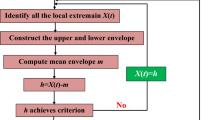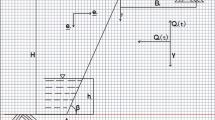Abstract
In this paper, the seismic stability of the #1 surge chamber of the Baihetan hydropower plant, which is influenced by a large dominating geological discontinuity [the interlayer shear weakness zone (ISWZ) C2)], is studied. An advanced, nonlinear, continuously yielding (CY) model was adopted to describe the complex mechanical properties of ISWZ C2. This model considers a power function type, normal stress dependent behavior and the progressive damage that occurred during shear tests. The applicability of the CY model is proved via a comparison with field test results and the theoretical solution. Verification work was conducted in 3DEC code to show that the 3DEC software is suitable for implementing this model. Three ground motion waveforms were utilized to conduct a seismic analysis of the #1 surge chamber after a special response spectrum matching process. The seismic analysis confirmed the control effect of ISWZ C2 on the seismic stability of the cavern. The majority of the cavern’s seismic displacement consists of elastic body movement, while the plastic deformation is relatively limited. Further, most of the deformations were caused by the contact deformation of C2. For the contact deformation of C2, the magnitude of permanent shear deformation is larger than that of the normal deformation. The magnitude of permanent shear deformation is more notable along the strike direction of C2, and the permanent normal displacement n of C2 mainly occurs along the dip direction of C2. Finally, the seismic stability of the cavern is assessed via the overload method. The seismic safety factor of the cavern is approximately 2–3.



























Similar content being viewed by others
Abbreviations
- \(c\) :
-
Cohesion
- \(C\) :
-
Stress wave velocity
- \(C_{\text{p}}\) :
-
P wave velocity
- \(C_{\text{s}}\) :
-
S wave velocity
- CY model:
-
Continuously yielding model
- \(d\) :
-
Discontinuity closure in BB model
- \(d_{\text{ma}}\) :
-
Maximum allowable closure in BB model
- \({\text{en}}\) :
-
Joint normal stiffness exponent of CY model
- \({\text{es}}\) :
-
Joint shear stiffness exponent of CY model
- \(f\) :
-
Wave frequency
- gal:
-
Galileo
- ISWZ:
-
Interlayer shear weakness zone
- \(K_{\text{n}}\) :
-
Normal stiffness
- \(K_{\text{s}}\) :
-
Shear stiffness
- PGA:
-
Peak ground acceleration
- PSHA:
-
Probabilistic seismic hazard analysis
- \(r\) :
-
Joint roughness parameter of CY model
- \(R\) :
-
Reflection coefficient
- \(R_{\text{non}}\) :
-
Reflection coefficient by CY model
- \(R_{\text{lin}}\) :
-
Reflection coefficient by linear model
- \(T_{\text{non}}\) :
-
Transmission coefficient by CY model
- \(T_{\text{lin}}\) :
-
Transmission coefficient by linear model
- \(Z\) :
-
Impedance of the rock mass medium
- \(a_{\text{n}}\) and \(K_{\text{ni}}\) :
-
Joint initial normal stiffness of CY model
- \(a_{\text{s}}\) and \(K_{\text{si}}\) :
-
Joint initial shear stiffness of CY model
- \(\beta\) :
-
Nonlinear factor in CY model, equals \(\sigma_{\text{n}}^{\text{en}}\)
- \(\gamma\) :
-
Nonlinear factor in BB model
- \(\theta\) :
-
Friction angle
- \(\rho\) :
-
Density of the rock mass
- \(\emptyset\) :
-
Joint initial friction angle of CY model
- \(\emptyset_{\text{m}}\) :
-
Effective friction angle of CY model
- \(\omega\) :
-
Angular wave frequency
- \(\varDelta \sigma_{\text{n}}\) :
-
Incremental normal contact stress
- \(\varDelta u_{\text{n}}\) :
-
Incremental normal contact displacement
- \(\varDelta \tau\) :
-
Incremental shear contact stress
- \(\varDelta u_{\text{s}}\) :
-
Incremental shear contact displacement
References
Asakura T, Sato Y (1998) Mountain tunnels damage in the 1995 Hyogoken-Nanbu earthquake. Q Rep Railw Tech Res Inst 39:9–16
Aydan, Ö., Genis M., 2008. The Seismic Effects on the Bukit-Tinggi WWII Underground Shelter by 2007 Singkarak (Solok) Earthquake. In: Proceedings of the ISRM international symposium 2008, Fifth Asian Rock Mechanics Symposium, Tehran, Iran, 24–26 November 2008: 917–924. Salzburg: International society of Rock Mechanics
Aydan Ö, Ohta Y, Geniş M, Tokashiki N, Ohkubo K (2010) Response and stability of underground structures in rock mass during earthquakes. Rock Mech Rock Eng 43:857–875
Bandis SC, Lumsden AC, Barton NR (1983) Fundamentals of rock fracture deformation. Int J Rock Mech Min Sci Geomech Abstr 20(6):249–268
Barton NR, Bandis S (1990) Review of predictive capabilities of JRC-JCS model in engineering practice. In: Barton N, Stephansson O (eds) Rock joints, proc. int. symp. on rock joints, Loen, Norway, 603–610. Rotterdam: Balkema
Biggs JM (1964) Introduction to structural dynamics. McGraw-Hill, New York
Chang SP, Seo JM (1997) Seismic fragility analysis of underground rock caverns for nuclear facilities. In: Transaction of the 14th international conference on structural mechanics in reactor technology, Lyon, France, 17–22 August 1997, vol: 10:151–158. Raleigh: SMiRT
Chen JC, Chang YL, Lee HC (2004) Seismic safety analysis of Kukuan underground power cavern. Tunn Undergr Space Technol 19:516–527
China Earthquake Administration (2003) Exhaustive probabilistic seismic hazard analysis of the Baihetan Hydropower Project, Jinsha river. Beijing (in Chinese)
China Institute of Water Resources and Hydropower Research (2000) Specifications for seismic design of hydraulic structures. Beijing, China State Economic and Trade Commission (in Chinese)
Chinese Ministry of Coal Industry, Coal Mines Planning and Design Institute (1982) Damage to structures and installations in the underground excavations of the Kailuan Colliery during the Tangshan Earthquake. Earthq Eng Eng Vib 2:67–77 (in Chinese)
Cundall PA, Lemos JV (1990) Numerical simulation of fault instability with the continuously yielding joint model. In: Fairhurst (ed) Rockbursts and seismicity in mines. Balkema, Rotterdam, pp 147–152
Dowding CH, Belytschko TB, Dmytryshyn O (2000) Dynamic response of Million Block Cavern models with parallel processing. Rock Mech Rock Eng 33:207–214
Genis M, Aydan Ö (2007) Static and dynamic stability of a large underground opening. In: Proceedings of the second symposium on underground excavations for transportation, Istanbul, Turkey, 15–17 November, 2007: 317–326, Istanbul: TMMOB (in Turkish)
Goodman RE (1989) Introduction to rock mechanics, 2nd edn. Wiley, New York
Hancock J, Watson-lamprey J, Abrahamson NA (2006) An improved method of matching response spectra of recorded earthquake ground motion using wavelets. J Earthq Eng 10(sup. 1):67–89
Itasca Consulting Group (2013) 3DEC user’s manual (version 5.0). Minneapolis, USA
Jones JP, Whittier JS (1967) Waves at a flexibly bonded interface. J Appl Mech 40:905–909
Kudoyarov LI, Sukhanov GK, Buné VI, Natarius Ya I, Radchenko VG, Savich AI, Khrapkov AA (1989) State of hydropower installations in Armenia after the Spitak earthquake. Power Tech Eng 23:450–455
Kuhlemeyer RL, Lysmer J (1973) Finite element method accuracy for wave propagation problems. J Geotech Geoenviron 99:421–427
Li TB (2011) Damage to mountain tunnels related to the Wenchuan Earthquake and some suggestions for Aseismic Tunnel construction. Bull Eng Geol Environ 71:297–308
Li JC, Ma GW (2009) Analysis of blast wave interaction with a rock joint. Rock Mech Rock Eng 43:777–787
Pande GN, Beer G, Williams JR (1990) Numerical methods in rock mechanics. Wiley, New York
PowerChina Huadong Engineering Corporation, Limited (ECIDI) (2006) Engineering geology report for dam site selection of the Baihetan hydropower station at the feasibility study stage. Hangzhou (in Chinese)
PowerChina Huadong Engineering Corporation, Limited (ECIDI) (2012) Detailed design scheme of underground powerhouse at the Baihetan hydropower station. Hangzhou (in Chinese)
Pyrak-Nolte LJ (1988) Seismic visibility of fractures. University of California, Berkeley
Pyrak-Nolte LJ (1996) The seismic response of fractures and the interrelations among fracture properties. Int J Rock Mech Min 33:787–802
Wang WL, Wang TT, Su JJ, Lin CH, Seng CR, Huang TH (2001) Assessment of damages in mountain tunnels due to the Taiwan Chi-Chi Earthquake. Tunn Undergr Space Technol 16:133–150
Wang ZZ, Gao B, Jiang YJ, Song Y (2009) Investigation and assessment on mountain tunnels and geotechnical damage after the Wenchuan earthquake. Sci China Ser E Technol Sci 52:546–558
Wu Q (2012) The mechanical parameters of jointed rock mass: scale-effect research and its engineering application. China University of Geosciences, Wuhan (in Chinese)
Wu Q, Kulatilake PHSW (2012) REV and its properties on fracture system and mechanical properties, and an orthotropic constitutive model for a jointed rock mass in a dam site in China. Comp Geol 43:124–142
Xu DP, Feng XT, Cui YJ (2013) An experimental study on the shear strength behavior of an interlayered shear weakness zone. Bull Eng Geol Environ 72:327–338
Xu DP, Feng XT, Cui YJ et al (2015) Use of the equivalent continuum approach to model the behavior of a rock mass containing an interlayer shear weakness zone in an underground cavern excavation. Tunn Undergr Space Technol 47:35–51
Zhang Y. H., Fu X. D., Sheng Q., 2014. Modification of the discontinuous deformation analysis method and its application to seismic response analysis of large underground caverns. Tun. Undergr. S. P. Technol., 40, 241-250
Zhao XB (2004) Theoretical and numerical studies of wave attenuation across parallel fractures. Nanyang Technological University, Singapore
Zhao J, Cai JG (2001) Transmission of elastic P-waves across single fractures with a nonlinear normal deformational behavior. Rock Mech Rock Eng 34:3–22
Zhao BY, Ma ZY (2009) Influence of cavern spacing on the stability of large cavern groups in a hydraulic station. Int J Rock Mech Min 46(3):506–513
Acknowledgments
The study was financially supported by the National Basic Research Program of China (No. 2015CB057905), the National Natural Science Foundation of China, (Nos. 51409263, 11472292).
Author information
Authors and Affiliations
Corresponding author
Rights and permissions
About this article
Cite this article
Cui, Z., Sheng, Q. & Leng, X. Control Effect of a Large Geological Discontinuity on the Seismic Response and Stability of Underground Rock Caverns: A Case Study of the Baihetan #1 Surge Chamber. Rock Mech Rock Eng 49, 2099–2114 (2016). https://doi.org/10.1007/s00603-015-0908-6
Received:
Accepted:
Published:
Issue Date:
DOI: https://doi.org/10.1007/s00603-015-0908-6




